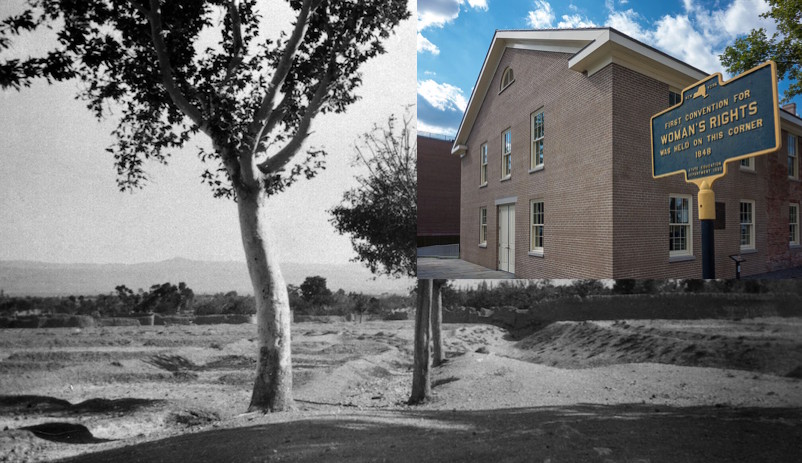
1848 – The Year of Two World Changing Conferences
 1848 is usually remembered as the year of revolutions in Europe. Those revolutions – although sweeping across Europe – changed little.
1848 is usually remembered as the year of revolutions in Europe. Those revolutions – although sweeping across Europe – changed little.
At the same time however, something of far greater moment was taken place, two small conferences. Although very few noticed at the time, a central idea of those conferences has already unfolded in unimagined transformation of human society across the planet. As Louise Dittmar, an advocate of the time, wrote in 1849:
The freedom of women is the greatest revolution, not just of our own day, but of all time, since it breaks fetters which are as old as the world.
And indeed in 1848, the emancipation of women was proclaimed at conferences held almost at the same time but far apart on the planet, in places with different cultural history, but where the aspiration emerged in apparent synchronicity.
In the Americas, in July of 1848, a small number of visionary thinkers (women and a few men) gathered for a conference on women’s rights in the rural town of Seneca Falls in the state of New York.
In June and July of the same year in the rural hamlet of Badasht in the country of Persia, visionary thinkers also gathered, although their purpose was broader.
The gatherings were both informed and motivated by religious faith – in the first case – Christians of various denominations whose religious vision informed the transformation they believed essential. At the second – Babis who gathered to debate the nature of their newly born faith. At both, the emancipation of women was proclaimed, though in different ways and in different contexts. Both conferences have given us heroes who advanced the rights of women: Lucretia Mott and Cady Stanton at Seneca Falls and Tahirih at Badasht, now a recognised inspiration for the women’s movement in Iran as well as to many others, including Baha’is. At both conferences there were sharp divergences on what was to be done.
At Seneca Falls, although eventually carried, whether to call for the vote for women, was hotly debated, with even Lucretia Mott concerned that the time was premature. The debate was carried by Cady Stanton with the help of Frederick Douglass, a freed African American who was a leading advocate both against slavery and for the emancipation of women.
At Badasht, the point of controversy was Tahirih’s appearance unveiled. A symbol of departure from the old ways and a call for the new. It occurred in the context of Tahirih’s own assertion and practice of her right to enter and lead in the public space. In 1848, Tahirih was defended by Baha’u’llah against those who did not share her vision. When Baha’u’llah’s own mission began, only a few years later, equality of men and women was one of the central elements of his teachings.
A beautiful document adopted at Seneca Falls, although it is less well known than it deserves, is the Declaration of Sentiments. It catalogues the injustice to which women in that country were then subject. In one way or another, the situation was similar everywhere. Here are some extracts.
The history of mankind is a history of repeated injuries and usurpations on the part of man toward woman, having in direct object the establishment of an absolute tyranny over her. To prove this, let facts be submitted to a candid world.He has never permitted her to exercise her inalienable right to the elective franchise.He has compelled her to submit to laws, in the formation of which she had no voice.He has withheld from her rights which are given to the most ignorant and degraded men – both natives and foreigners.Having deprived her of this first right as a citizen, the elective franchise, thereby leaving her without representation in the halls of legislation, he has oppressed her on all sides.He has taken from her all right in property, even to the wages she earns.He has monopolized nearly all the profitable employments, and from those she is permitted to follow, she receives but a scanty remuneration.He closes against her all the avenues to wealth and distinction, which he considers most honorable to himself. As a teacher of theology, medicine, or law, she is not known.He has denied her the facilities for obtaining a thorough education – all colleges being closed against her …
Selected Sources: A number of sources note the parallels between Badasht and Seneca Fall. For example, Badasht and Seneca Fall, in Words, Not Swords: Iranian Women Writers and the Freedom of Movement
by Farzaneh Milani and Seneca Falls First Woman’s Rights Convention of 1848* The Sacred Rites of the Nation by Bradford Miller.






